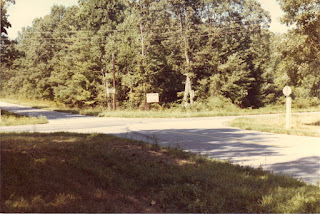Are all these stories true?
 |
| The crossroads of Brookwood and McGinnis Ferry roads in 1980. |
Some of these stories are based in truth.
Some of these stories should have been true.
That's the disclaimer appearing on the Dedication page of both Brookwood Road and Elm Street, and it will appear in future books as well. Yet people are always asking, "Are these stories true?" My answer: See the disclaimer.
Let's look at Chapter 25 (The Crossroads) in my book, Brookwood Road. That chapter, like most of my chapters, is about 2,500 words. The gist of the story is that Frank (the main character) is finally allowed to ride his bicycle down Brookwood Road to the old crossroads. This was a big deal because riding a bicycle to the crossroads meant he was out of sight of his house and there was a bit of danger involved. Brookwood Road was notorious for speeding cars.
I could have taken that synopsis, and flushed it out to about 700 words. Frank rides his bicycle on a dangerous road to the crossroads. But, so what? What if Frank also encountered some local bullies when he got to the crossroads, and what if that encounter led to future encounters? Now, we have an interesting story that kind of blossoms over about 5,000 words. The story becomes about Frank and the bullies with the crossroads as a backdrop.
So, I took the basic story - Frank rides his bicycle to the crossroads, and I added 2-3 other stories occurring at different times in my life to that story to make all of it a lot more interesting. Standing on its own, is it true? No, not exactly as it is written, but all the elements of it are true on a different timeline. So, it's based in truth to make all of it a much better story.
One of the things I've learned through this writing project and about storytelling (thank you, William) is that great stories always involve conflict. Who is the main character? What does the main character want to accomplish? What stands in the way of that accomplishment? How is it resolved? As you write, how deeply can you bring the reader into the conflict?
With The Crossroads story, Frank is the main character. He wants to ride his bicycle to the crossroads. In riding his bicycle to the crossroads he stirs up some bullies, who then work to disrupt the joy he has in day-to-day living, and it's ultimately resolved in a later chapter.
A good friend of mine (thank you, David) accurately said he felt all of my stories included some truth even if it was a thread of truth or the combination of a few stories to make one story, changing things up to make it all fit together. That's true.
My son, William, said it like this: "Every memoir includes some fiction, and most fiction is based on memories."
Maybe you can understand now why it was important for me to write in third-person. Writing the books as third-person fiction, changing many of the names and some of the places, further allowed me to bend and stretch the truth without someone constantly saying, "It didn't happen that way."
In the book Elm Street, there is a chapter titled Wendell Mann (thank you, Keith for not suing me). My dear friend Keith Stone, who inspired the character of Wendell Mann called and said of one story, "I don't remember that happening to me." I replied, "Well, maybe it didn't exactly happen like that to you, but it certainly happened to Wendell Mann."
Have a question about a story from one of the books? You can email me at sharketing411@gmail.com.
www.scottdvaughan.com



Comments
Post a Comment